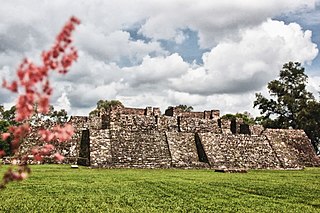 W
WThe Aztec religion originated from the indigenous Aztecs of central Mexico. Like other Mesoamerican religions, it also has practices such as human sacrifice in connection with many religious festivals which are in the Aztec calendar. This polytheistic religion has many gods and goddesses; the Aztecs would often incorporate deities that were borrowed from other geographic regions and peoples into their own religious practices.
 W
WAhuiyateteo [awiyateteo] or Macuiltonalehqueh [makʷiɬtonaleke] were a group of five Aztec gods of excess and pleasure. They also represented the dangers that come along with these. These five gods were also invoked by diviners and mystics. They were associated with the Tzitzimimeh, a group of frightening beings that personified death, drought, and war.
 W
WIn Aztec mythology, Atlahua, Ahtlahua, Atlahoa, Atlavâ or Atlaua [aˈtɬawa] was a water God, fisherman and archer. There were said to be at least four ancient Aztec temples at which he was worshiped, the tallest supposedly being over 200 feet tall. The Aztecs prayed to him when there were deaths in water, such as when Hernando Cortez conquered Tenochtitlan, and the lake was said to be "floating with heads and corpses".
 W
WIn Aztec mythology, the Centzonhuītznāhua were the gods of the southern stars. They are the elder sons of Cōātlīcue, and their sister is Coyolxāuhqui. They and their sister tried to murder their mother upon learning of her pregnancy with Huītzilōpōchtli; their plan was thwarted when their brother sprang from the womb—fully grown and garbed for battle—and killed them all.
 W
WChalchiuhtlicue [t͡ʃaːɬt͡ʃiwˈt͡ɬikʷeː] is an Aztec deity of water, rivers, seas, streams, storms, and baptism. Chalchiuhtlicue is associated with fertility and she is the patroness of childbirth. Chalchiuhtlicue was highly revered in Aztec culture at the time of the Spanish conquest and she was an important deity figure in the Postclassic Aztec realm of central Mexico. Chalchiuhtlicue belongs to a larger group of Aztec rain gods and she is closely related to another Aztec water god, Chalchiuhtlatonal.
 W
WChanekeh, Chaneque or Ohuican Chaneque, as they were called by the Aztecs, are legendary creatures in Mexican folklore. In Náhuatl, chaneque means "those who inhabit dangerous places" or the "owners of the house". They are conceived of as small, sprite-like beings, elemental forces and guardians of nature. Similar mythical beings are common in Mesoamerican and other Latin American folkloric traditions, generally referred to in Spanish as duende. In the folkloric tradition of the Yucatán Peninsula, these elementals are known by their Yucatec Mayan name aluxob.
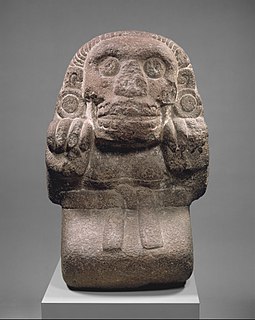 W
WIn Aztec mythology, the Cihuateteo or "Divine Women", were the malevolent spirits of women who died in childbirth. They were likened to the spirits of male warriors who died in violent conflict, because childbirth was conceptually equivalent to battle in Aztec culture. According to tradition, a woman in labor was said to capture the spirit of her newborn child similar to the way a warrior captures his opponent in battle. These spirits are also associated with the west, the place where the sun sets each day.
 W
WDogs have occupied a powerful place in Mesoamerican folklore and myth since at least the Classic Period right through to modern times. A common belief across the Mesoamerican region is that a dog carries the newly deceased across a body of water in the afterlife. Dogs appear in underworld scenes painted on Maya pottery dating to the Classic Period and even earlier than this, in the Preclassic, the people of Chupícuaro buried dogs with the dead. In the great Classic Period metropolis of Teotihuacan, 14 human bodies were deposited in a cave, most of them children, together with the bodies of three dogs to guide them on their path to the underworld.
 W
WThe Dumbarton Oaks birthing figure is a possibly Aztec scapolite figurine of a woman giving childbirth in a squatting position. Housed in the Dumbarton Oaks collection, United States, the figurine is considered by several scholars to be a pre-Columbian artwork, while others believe it was made in modern times, possibly in the 19th century. The figurine measures 20.2 cm in height.
 W
WHuehueteotl WAY-way-TAY-oh-təl; Nahuatl pronunciation: [weːweˈteoːt͡ɬ] is an aged Mesoamerican deity figuring in the pantheons of pre-Columbian cultures, particularly in Aztec mythology and others of the Central Mexico region. The spellings Huehuetéotl and Ueueteotl are also used. Although known mostly in the cultures of that region, images and iconography depicting Huehueteotl have been found at other archaeological sites across Mesoamerica, such as in the Gulf region, western Mexico, Protoclassic-era sites in the Guatemalan highlands such as Kaminaljuyú and Late-Postclassic sites on the northern Yucatán Peninsula. The name Huehueteotl stems from Nahuatl huēhueh [ˈweːweʔ] ("old") and teōtl [ˈteoːt͡ɬ] ("god"). It seems to connect the Old God to certain Mayan deities called Mam ("Grandfather").
 W
WHuman sacrifice was common in many parts of Mesoamerica, so the rite was nothing new to the Aztecs when they arrived at the Valley of Mexico, nor was it something unique to pre-Columbian Mexico. Other Mesoamerican cultures, such as the Purépechas and Toltecs, performed sacrifices as well and from archaeological evidence, it probably existed since the time of the Olmecs, and perhaps even throughout the early farming cultures of the region. However, the extent of human sacrifice is unknown among several Mesoamerican civilizations. What distinguished Maya and Aztec human sacrifice was the way in which it was embedded in everyday life and believed to be a necessity. These cultures also notably sacrificed elements of their own population to the gods.
 W
WThe practice of human sacrifice in pre-Columbian cultures, in particular Mesoamerican and South American cultures, is well documented both in the archaeological records and in written sources. The exact ideologies behind child sacrifice in different pre-Columbian cultures are unknown but it is often thought to have been performed to placate certain gods.
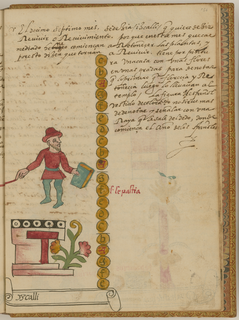 W
WIzcalli is the name of the Eighteenth and last month of the Aztec calendar. It is also a festival in the Aztec religion, the principal deity is Xiuhtecuhtli the fire God and old People are honored this month and is known as Rebirth Month.
 W
WIn Mesoamerican mythology the Lords of the Night are a set of nine gods who each ruled over every ninth night forming a calendrical cycle. Each lord was associated with a particular fortune, bad or good, that was an omen for the night that they ruled over.
 W
WMexitli, Mexi, or Mezih was a legendary great leader and war priest of the Aztecs during the wandering years. According to Bernardino de Sahagún, the name derives from the Nahuatl metl and zitli.
 W
WAztec mythology is the body or collection of myths of Aztec civilization of Central Mexico. The Aztecs were Nahuatl-speaking groups living in central Mexico and much of their mythology is similar to that of other Mesoamerican cultures. According to legend, the various groups who were to become the Aztecs arrived from the north into the Anahuac valley around Lake Texcoco. The location of this valley and lake of destination is clear – it is the heart of modern Mexico City – but little can be known with certainty about the origin of the Aztec. There are different accounts of their origin. In the myth the ancestors of the Mexica/Aztec came from a place in the north called Aztlan, the last of seven nahuatlacas to make the journey southward, hence their name "Azteca." Other accounts cite their origin in Chicomoztoc, "the place of the seven caves," or at Tamoanchan.
 W
WIn Mesoamerican folk religion, a nagual is a human being who has the power to shapeshift into a jaguar form.
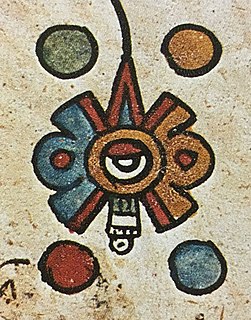 W
WNahui Ollin is a concept in Aztec/Mexica cosmology with a variety of meanings. Nahui translates to "four" and Ollin translates to "movement" or "motion." Ollin was primarily portrayed in Aztec codices as two interlaced lines which are each portrayed with two central ends. Nahui Ollin has been used as an educational framework, particularly in social justice and ethnic studies institutions.
 W
WThe New Fire Ceremony was an Aztec ceremony performed once every 52 years—a full cycle of the Aztec “calendar round”—in order to stave off the end of the world. The calendar round was the combination of the 260-day ritual calendar and the 365-day annual calendar. The New Fire Ceremony was part of the “Binding of the Years” tradition among the Aztecs.
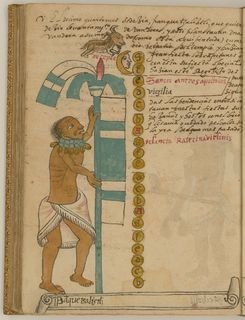 W
WPanquetzaliztli is the name of the fifteenth month of the Aztec calendar. It is also a festival in the Aztec religion dedicated to Huitzilopochtli. The correlation of Rafael Tena places the 20-day month last from November 30 to December 19.
 W
WIn Aztec mythology, Piltzintecuhtli [piɬt͡sinˈtekʷt͡ɬi] was a god of the rising sun, healing, and visions, associated with Tōnatiuh. The name means "the Young Prince". It may have been another name for Tōnatiuh, but he is also mentioned as a possibly unique individual, the husband of Xōchiquetzal. He was the lord of the third hour of the night. Piltzintecuhtli was said to be the son of Oxomoco and Cipactonal and was seen as a protector of children. He was identified as the Youthful Sun.
 W
WPulque, or octli, is an alcoholic beverage made from the fermented sap of the maguey (agave) plant. It is traditional in central Mexico, where it has been produced for millennia. It has the color of milk, a rather viscous consistency and a sour yeast-like taste.
 W
WIn Aztec mythology, the Quinametzin populated the world during the previous era of the Sun of Rain (Nahui-Quiahuitl). They were punished by the gods because they did not venerate them, and their peak-civilization came to an end as a result of great calamities and as a punishment from the heavens for grave sins they had committed. The construction of the pyramid of Cholula and the City of Teotihuacan was attributed to the Quinametzin Giants.
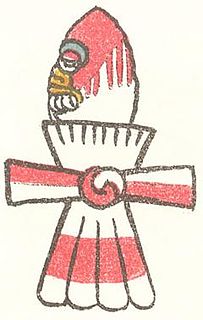 W
WIn the Aztec culture, a tecpatl was a flint or obsidian knife with a lanceolate figure and double-edged blade, with elongated ends. Both ends could be rounded or pointed, but other designs were made with a blade attached to a handle. It can be represented with the top half red, reminiscent of the color of blood, in representations of human sacrifice and the rest white, indicating the color of the flint blade.
 W
WTecuilhuitontli is the name of the Seventh month of the Aztec calendar. It is also a festival in the Aztec religion. The principal deity is Xochipilli and feasts are also given to Goddess Huixtocihuatl and it is known as the Small Festival of the Lords.
 W
WTeotleco is the name of the twelfth month of the Aztec calendar. It is also a festival in the Aztec religion and is known as the festival of All gods where all gods are worshiped.
 W
WTepeilhuitl is the name of the thirteenth month of the Aztec calendar. It is also a festival in the Aztec religion dedicated to Popocatepetl, Iztaccihuatl and Tlaloc. It is called the festival or feast of the Mountains.
 W
WThe tonalamatl [toːnaˈlaːmatɬ] is a divinatory almanac used in central Mexico in the decades, and perhaps centuries, leading up to the Spanish conquest. The word itself is Nahuatl in origin, meaning "pages of days".
 W
WToxcatl was the name of the fifth twenty-day month or "veintena" of the Aztec calendar which lasted from approximately the 5th to 22 May and of the festival which was held every year in this month. The Festival of Toxcatl was dedicated to the god Tezcatlipoca and featured the sacrifice of a young man who had been impersonating the deity for a full year.